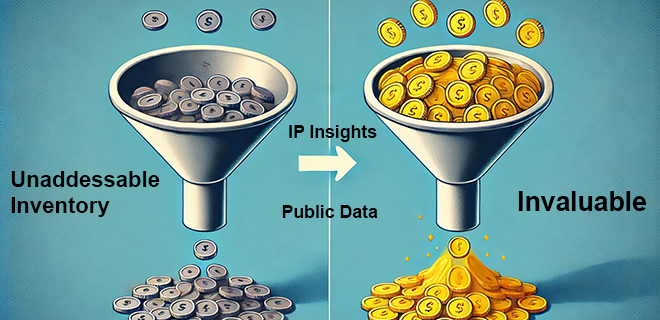
Discover how publishers can turn unaddressable inventory into a revenue goldmine. Digiseg CEO, Søren H. Dinesen, explains how public data and IP-based insights help bridge the CPM gap and maximize value in a post-cookie world.
Third-party cookie deprecation has created a pricing crisis for publishers.
When readers can’t be identified, ad inventory sells at a steep discount—sometimes 70-80% below addressable rates. But publishers aren’t doomed to these fire-sale prices.
Some solutions can help them bridge the gap between addressable and unaddressable inventory and allow them to recover lost revenue, even as cookies rapidly fade away.
The Addressability Gap
The addressability gap is real and growing.
Research by Digiseg and AdExchanger illustrates the stark reality facing publishers: While addressable impressions fetch high prices (averaging $12.74 CPM), Safari/iOS and non-consented audiences fetch just $3.78 and $2.44 CPMs, respectively.
This gap represents a significant revenue loss that will only grow as Chrome users begin to opt out of tracking en masse.
Here’s what really stinks for publishers: iOS users, by definition, are premium audiences.
Nearly 50% of iPhone users have household incomes over $100,000, and research shows that iPhone users have an average annual salary of $53,251 compared to $37,040 for Android users. Publishers should get a lot more than $3.78 CPM for these users.
What’s more, unaddressable inventory on iOS devices is less susceptible to bot traffic, making it a reliable source of human impressions.
Finally, there are publisher’s advertising partners to consider. Brands that avoid Safari users miss a crucial opportunity to reach new consumers. The impulse to eschew unaddressable inventory means these brands are effectively surrendering their future growth to fear.
So what’s to be done? Here’s where public and IP-based data come into play.
Public Data As a Solution
Public data refers to all of the anonymized and vetted information that’s collected on a regular basis by National Statistics Offices, such as the U.S. Census Bureau and other civic sources. For publishers, public data offers two critical advantages: scale and reliability.
Scale comes into play because public data applies to nearly the entire population, not just the limited pools of users for whom publishers have a cookie or identifier.
The data’s reliability stems from the fact that much of the audience data is based on stable, long-term characteristics of the consumer, such as household income, homeownership, number of children, and education levels. Once you have a kid, that kid is likely to live with you for eighteen years.
When combined with IP-based insights—i.e. knowing that a particular IP address is associated with a home, office, or in transit—publishers can turn unaddressable inventory into rich audience profiles.
Here’s an example: Let’s say a visitor to a publisher’s site has an IP address that indicates they’re from a particular neighborhood and they are accessing the site at home. Meanwhile, public data shows that the neighborhood is full of starter homes with young families who have college degrees.
These data points combine into a telling profile: This visitor is likely to have children and is upwardly mobile, making them an ideal target for a brand that sells children’s clothing made of organic cotton. And because the IP address shows home browsing, it suggests that the consumer is relaxed and receptive to discovering new brands and learning their stories
A publisher’s ability to connect these dots becomes super valuable for an advertiser targeting parents. The publisher can help the marketer reach, at scale, an audience that is open to ads and has a validated need for children’s clothes. In addition to precise targeting, this approach lets their advertising partners reach their audiences while respecting the consumer’s privacy.
Busting the Myth That All Unaddressable Inventory Is Crap
Unaddressable inventory faces two challenges: buyer unfamiliarity and buyer mistrust.
Only a handful of U.S. ad tech companies offer targeting by public data, and the proliferation of MFA sites has made buyers wary of any inventory they can’t validate.
Still, Safari and Firefox traffic from legitimate publishers isn’t low quality by any stretch of the imagination. But it needs to be approached from an angle that is a bit outside of business as usual.
The solution isn’t that hard: Just combine curated URL lists with public data insights, and voila! advertisers have a way to identify premium, brand-safe inventory within the mass of unaddressable stuff.
For publishers, this approach offers a competitive advantage.
Since GDPR, brands have publicly professed deep respect for consumer privacy but continued to track via third-party cookies whenever possible because it’s what they know. But now publishers can offer their advertising partners an approach that is ethical, scalable, and aligns with their stated values.
The True Untapped Opportunity of Your Unaddressable Inventory
The massive CPM gap isn’t just a headache—it’s your chance to reinvent how you sell inventory.
Smart publishers are already combining public data with IP insights to turn “unaddressable” into “invaluable.”
What’s more, you’re not just recovering lost revenue, you’re finally offering what brands claim they want: ethical, scalable targeting that actually works.